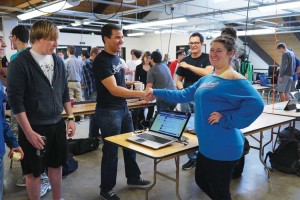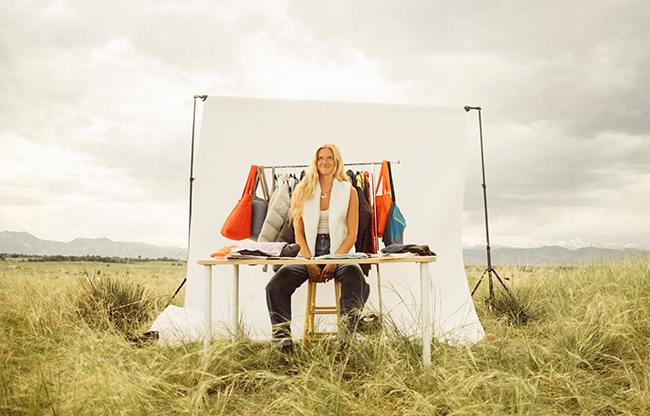Boomtown, a new tech-accelerator program, helps fuel Boulder’s startup community
05 Sep 2015
Accelerating Ideas
Last winter, Aidan Chopra was standing in line for dinner at Five Guys in Boulder with his wife and 3-year-old son when his phone started beeping furiously. It was Kickstarter sending him alerts. In the few minutes it took the 39-year-old to order his bacon cheeseburger and sit down to eat, he and Scott Lininger, his business partner, had raised $12,000 for their startup Bitsbox. “Bitsbox started because my 7-year-old daughter asked me how to code,” says Lininger, who taught himself to code at age 7 and sold his company to Google in 2007. “It was a really emotional moment as I thought back on what got me on this path. I’ve been all over the world, and it’s because I know how to code.” Today, kids can learn how to code through a Bitsbox subscription. Every month a yellow box arrives through the mail with code activities, stickers and other fun giveaways. But these yellow boxes might not exist if it weren’t for Boomtown, a 12-week-long Boulder startup accelerator program that launched in 2014. Offered twice a year, Boomtown provides participants like Chopra and Lininger with $20,000, shared office space in downtown Boulder, a tailored curriculum and more. It also matches them with top-notch mentors. The intensive program culminates in Demo Day at Boulder Theater, where participants pitch their companies to investors and the larger startup community.
The Couples Thing
And when you start talking to entrepreneurs like Vieitez or Krout, you discover the nuances of the startup subculture. First, there’s the “couples” thing. They often finish each other’s sentences and retrace the conversation if the other’s train of thought derails. They use terms like “speed-dating” to describe meetings that led to business partnerships, and “matchmaking” when talking about professionally connecting people. Maybe this shouldn’t be a surprise. Some of the world’s most famous startups were founded by twosomes. Think Apple’s Steve Jobs and Steve Wozniak. Larry Page and Sergey Brin of Google. Microsoft’s Bill Gates and Paul Allen. Sitting across from Chopra and Lininger at the Pekoe Sip House in the Steelyards is like watching a strictly platonic version of the 1989 comedy When Harry Met Sally. But they are funnier, more creative and smarter than Harry and Sally ever were. Which, with help from Boomtown, is why they were able to take a desire to teach kids how to code and transform it into a successful business. “Before Boomtown, we knew we had a product,” Lininger says. “We had tested it. But we didn’t have a business. We almost stopped working on the product at Boomtown so we could focus on our business model.” Chopra starts laughing and adds, “We spent this unbelievably romantic summer [before enrolling in Boomtown] in my craft room talking about our idea. We flew kites. People would ask, ‘Who is your target audience?’ And we were like, ‘Maybe kids?’” And this is exactly why Boomtown focuses on the entrepreneur. In 12 weeks, its tailor-made curriculum helps them learn everything they need to know. It also connects participants with mentors in diverse disciplines like publishing, technology and design. Mentors include John Zimmer, founder of Uber’s competitor Lyft, and Aaron Kennedy, president and CEO of Noodles & Co. “If you have a great accelerator program, you can bring in really smart people who are in a really interesting space without a product,” Krout says. He points to Visibl, one of the most successful companies in Boomtown’s portfolio, which enables customers to create their own video ad campaigns. It came in with just an idea and a great plan. There was no product or even a prototype. But by week six, the crew was generating revenue. For Bitsbox, learning about investors proved critical. “We got a crash course in investment,” says Lininger, who had never raised money from investors. “Investors have a huge vocabulary of shorthand. Today, we use words we never used or heard of before.” That helped tremendously when he and Chopra found themselves peering into a small computer screen to talk to potential investors in China. Today, Bitsbox has almost 3,000 backers in 55 countries. When Krout’s two oldest children received their first Bitsbox delivery, his 10-year-old daughter, who never expressed interest in coding, spent four hours mesmerized by its contents. When she held up her laptop and said, “Dad, look—I’m a coder,” Krout grew emotional. “I thought, ‘We were part of that,’ he recalls. “I saw how positively it changed my kids’ lives. That epitomizes what success looks like. You have good people who make great things.”By Tori Peglar












